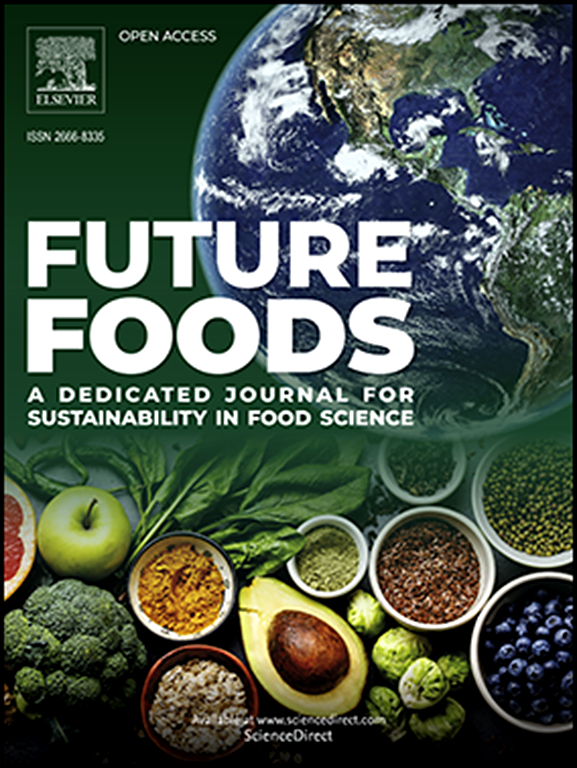Characterization of nanostructured chitosan-PVA films and their effects on blueberries during storage
IF 7.2
Q1 FOOD SCIENCE & TECHNOLOGY
引用次数: 0
Abstract
The use of nanotechnology in coatings has become a topic of growing interest. In this work, the effect of adding chitosan nanoparticles (NP) into chitosan/polyvinyl alcohol (PVA) coatings was studied. The cross-section of film micrographs obtained by scanning electron microscopy (SEM) showed a coarse surface for CS100, a smooth surface for PVA100 and blends morphology like CS100, except for the 33NP30PVA37CS and 33NP40PVA27CS films which were similar to PVA100. Fourier-transform infrared spectroscopy (FTIR) revealed interaction between the PVA and chitosan functional groups, which was reflected in the thermal and mechanical properties. The NP enhanced thermal stability and rigidity (Young´s modulus = 54.79 ± 3.94 MPa) with the highest crystallinity (52.71 %) of the films, and showing 100 % in vitro inhibition against B. cinerea for the 33NP67CS formulation. The postharvest evaluation for coated fruit showed a decrease in weight loss (< 5 %) and firmness (between 0.24–2.47 N). On the other hand, anthocyanin content increased during storage with values from 7 to 34 mg/100 g on day 8. Disease incidence was between 23 and 30 % and severity near 25 %. The nanostructured coating formulations preserve blueberry quality, making them an attractive option for sustainable food packaging.
纳米壳聚糖-聚乙烯醇膜的表征及其对蓝莓贮藏的影响
纳米技术在涂料中的应用已成为人们日益关注的话题。研究了壳聚糖纳米颗粒(NP)在壳聚糖/聚乙烯醇(PVA)涂料中的应用效果。扫描电镜(SEM)获得的膜显微截面图显示,除了33NP30PVA37CS和33NP40PVA27CS与PVA100相似外,CS100表面粗糙,PVA100表面光滑,与CS100形貌相似。傅里叶红外光谱(FTIR)揭示了PVA与壳聚糖官能团之间的相互作用,这反映在热性能和力学性能上。NP提高了膜的热稳定性和刚性(杨氏模量= 54.79±3.94 MPa),结晶度最高(52.71%),对33NP67CS配方的葡萄球菌有100%的体外抑制作用。包衣后的果实采后评价表明,包衣后的果实失重减少(<;另一方面,花青素含量随着贮藏时间的增加而增加,第8天的花青素含量为7 ~ 34 mg/100 g。发病率在23%至30%之间,严重程度接近25%。纳米结构的涂层配方保持蓝莓的质量,使它们成为可持续食品包装的一个有吸引力的选择。
本文章由计算机程序翻译,如有差异,请以英文原文为准。
求助全文
约1分钟内获得全文
求助全文
来源期刊

Future Foods
Agricultural and Biological Sciences-Food Science
CiteScore
8.60
自引率
0.00%
发文量
97
审稿时长
15 weeks
期刊介绍:
Future Foods is a specialized journal that is dedicated to tackling the challenges posed by climate change and the need for sustainability in the realm of food production. The journal recognizes the imperative to transform current food manufacturing and consumption practices to meet the dietary needs of a burgeoning global population while simultaneously curbing environmental degradation.
The mission of Future Foods is to disseminate research that aligns with the goal of fostering the development of innovative technologies and alternative food sources to establish more sustainable food systems. The journal is committed to publishing high-quality, peer-reviewed articles that contribute to the advancement of sustainable food practices.
Abstracting and indexing:
Scopus
Directory of Open Access Journals (DOAJ)
Emerging Sources Citation Index (ESCI)
SCImago Journal Rank (SJR)
SNIP
 求助内容:
求助内容: 应助结果提醒方式:
应助结果提醒方式:


